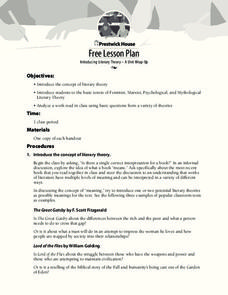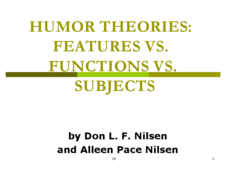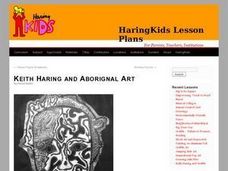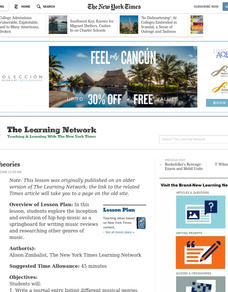Prestwick House
Introducing Literary Theory – A Unit Wrap-Up
Literary theories are lenses through which a text may be analyzed. The question in this lesson plan is how a particular literary lens can influence the reader's view of the text.
Marine Institute
Bubble Art – Learning About Paint and Color
To gain an understanding of color mixing theory and the color wheel, young artists draw a picture, mix up a batch of secondary colors to which they add dish soap, and using straws, bubble up the paint. They then press their drawings onto...
National Gallery of Canada
Class Commission
Simulate a real-life situation with a project proposal activity for an art installation. Learners look at work by Joe Fafard and examine his website for information about public art displays. They also search for other proposals for...
Curated OER
Color Theory & Using Layers
Students investigate the color wheel theory and incorporate it into simple sketches on their handheld. The importance of the use of layering and the difference between primary, secondary, and tertiary colors is presented in this lesson...
Curated OER
Humor Theories: Features vs. Functions vs. Subjects
Great for a psychology, sociology, or language arts lecture, this presentation focuses on the features, functions, and subjects of humor. Complete with definitions and examples of each category, as well as links to humorous videos and...
Curated OER
Should Art Be for Art's Sake?
Students examine how European-America aestheticians (philosophers of art) do not all agree about the value and definition of art. students examine how some cultures do not have a distinct word or definition for art.
North Birmingham Academy
Color Theory
What better way to learn about colors than by coloring? Starting with the primary colors, young artists follow written prompts to shade in various rectangles and a color wheel to show complementary colors, tints and shades, and more.
National Gallery of Canada
Artful Emotions
Blue is sad, and red is angry, but why is that? Young artists explore the expression of emotions through art by observing and creating artwork. Starting with a questioning session about images of art, this plan moves into a sculpture...
National Gallery of Canada
Memories of the Past
Explore contemporary American Indian art. After viewing a set of images, class members discuss the design elements of techniques present, as well as how these artists represent history and culture. Learners examine the parfleche and...
Curated OER
Art and Artists: Diversity of Learners Adaptation
Students determine the style of place cards as well as how to display phots of artwork. They organize and design an art museum for parents and other students to enjoy. Students create place cards to explain the artwork, artist, as well...
Curated OER
Keith Haring And Aboriginal Art
Young scholars explore the art of Keith Haring and examine how it relates to Aboriginal art. In this fundamentals of art instructional activity, students examine the fundamental elements of art, such as, line, symmetry, contrast,...
MENSA Education & Research Foundation
Introduction to Color: The Foundation of Art and Design
What is the most favorite color in the world? The series of lessons all about color and the color wheel, asks kids to research color, create an eye-spy activity, watch videos, and examine the color choices made by artists in their...
Great Books Foundation
On the Origin of Species
How did Charles Darwin support his controversial theory of evolution with evidence? Use an excerpt from his 1859 work On the Origin of Species to reinforce the importance of making inferences within an informational text, and to discuss...
National Gallery of Canada
Build Me a Legend
Legends are full of imagery and action. Transfer a scene from a legend to a three-dimensional art piece. Class members first view Inuit art and discuss legends. They then build scenes that include action, setting, and characters.
National Gallery of Canada
The Tools of Perspective
Make a study of perspective in the real world. Learners examine and discuss works of art that show examples of perspective before trying their own hands at it. Using a grid drawn on transparent paper, class members transfer a view from a...
National Gallery of Canada
My World
Art can tell viewers about an artist's personality and background. Have your learners look at Inuit art and consider subject matter and how it relates to the artist and his or her world. The related art project requires pupils to create...
National Gallery of Canada
Mastering One-Point Perspective
Cover one-point perspective through observation and practice. Class members examine several works of art that use one-point perspective, look at magazine images to find the vanishing points and horizon lines, and draw their own city...
National Gallery of Canada
My Own Tree
Nature contains both symmetry and asymmetry. Have your young artists examine symmetry and asymmetry in their own surroundings. After viewing works of art, pupils find trees in their neighborhoods and determine if they are symmetrical or...
National Gallery of Canada
Build a Neighbourhood
What's special about your neighborhood? Build one with your class to find out. Individuals create their dream homes that, when completed, will be placed together around a green space in order to create a neighborhood. Learners also...
Curated OER
Lesson: Nikhil Chopra: Performing Memory
Film imitates life; that's what they say. Using performance theory to tie the lesson plan together, learners attempt to understand memory and daily rituals as seen in art, film, and life. They read two chapters from the book, watch the...
Curated OER
Music Theories
Explore the inception and evolution of hip-hop music as a springboard for writing music reviews and researching other genres of music. Learners will read and discuss the Times' article, From Underground Music to Fashion Statement to then...
Curated OER
Art and the Berlin Wall
Students study the relationship between Cold War politics, the people who were affected by it, and the artists who examined it. They create their own "walls" using a spray paint graffiti procedure.
Fun Music Company
Completing Measures with Rests
Rests. Eighth rests, quarter rests, and half rests are the focus of a one-page worksheet that asks music theory students to complete a series of measures with rests and bar lines.
Fun Music Company
Treasure Island Clues: Intervals
You may know about A, B, and C, but now you can include "arrrrr" to the list of music notes to practice! Here is a fun pirate-themed activity in which young musicians determine the intervals of various notes in the treble clef to work...
Other popular searches
- Op Art Color Theory
- Formalism Art Theory
- Art Color Theory Worksheet
- Formalism Art in Theory
- Colour Theory and Art
- Art Color Theory Lessons
- Aboriginal Art Theory
- Co Lour Theory and Art
- Indigenous Art Theory

























